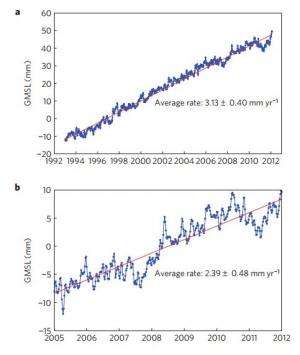June 3, 2013 report
New study finds sea level rose 2.4 mm/year between 2005 and 2011

(Phys.org) —A new study conducted by researchers at the University of Texas' Center for Space Research, indicates that sea level rise between 2005 and 2011 was due primarily to glacial and polar ice shelf melting. In their paper published in Nature Geoscience, the team describes how they studied data from satellites and ocean surface sensors to measure changes in ocean mass and density which allowed them to calculate an average global sea level rise of nearly 2.4mm/year.
The researchers note that sea level changes come about in three main ways: changes in the mass of the water in the ocean, its density, and changes in the volume of ocean basins. To measure all of these over the period 2005 to 2011, the team studied data from the Gravity Recovery and Climate Experiment (GRACE) and from the Argo project (a global array of 3,500 profiling floats that record ocean temperatures and salinity on an ongoing basis.)
Gravity data from GRACE allows researchers to measure the mass of the world's oceans (divided into six regions) and thus the changes that occur over time. The data showed, the researchers report, a global increase in ocean mass that led to an average ocean level rise of 1.8mm/year during the years studied. They suggest the increase in mass was due to melting of the polar ice sheets and glaciers atop mountains around the globe.
In studying data from Argo, the researchers found a reduction in the average density of the world's oceans led to a rise in sea levels of approximately 0.6mm/year. The researchers did not delve into the nature of the decrease in sea water density, but the presumption is that it's due to an increase in seawater temperature.
To calculate the total average sea level rise over the years studied, the researchers added the rise due to an increase in ocean mass and the rise due to a reduction in average density—this gave them an average global sea level rise of 2.39mm/year. The researchers note their numbers reflect more rise than other studies have found but agree with those that have claimed sea levels are rising at an accelerated rate in more recent years. They also conclude that most of the change in global sea levels is due to melting of polar ice sheets and mountain glaciers.
More information: Contribution of ice sheet and mountain glacier melt to recent sea level rise, Nature Geoscience (2013) doi:10.1038/ngeo1829
Abstract
Changes in global mean sea level primarily reflect the sum of three contributions: water mass changes in the oceans, water density changes, and variations in the volume of the ocean basins. Satellite altimetry data1, 2, 3, 4 suggest that sea level rose by about 2.39±0.48 mm yr−1 between 2005 and 2011. However, previous estimates5, 6, 7, 8, 9 of sea level rise from density and ocean mass changes were lower than the altimeter data indicate. Here we show that the gap in the sea level budget disappears when we combine gravity data from the GRACE (Gravity Recovery and Climate Experiment) satellite mission and temperature and salinity observations from the Argo programme collected between 2005 and 2011. The Argo data indicate a density-driven sea level rise of 0.60±0.27 mm yr−1 throughout this period. To estimate ocean mass change from the gravity data, we developed a forward modelling technique that reduces the bleeding of terrestrial signals into the ocean data. Our reassessment suggests an ocean mass contribution of 1.80±0.47 mm yr−1, for a total sea level rise of 2.40±0.54 mm yr−1, in agreement with the altimeter-based estimates. On the basis of the GRACE data, we conclude that most of the change in ocean mass is caused by the melting of polar ice sheets and mountain glaciers. This contribution of ice melt is larger than previous estimates10, but agrees with reports11, 12, 13 of accelerated ice melt in recent years.
Journal information: Nature Geoscience
© 2013 Phys.org


















